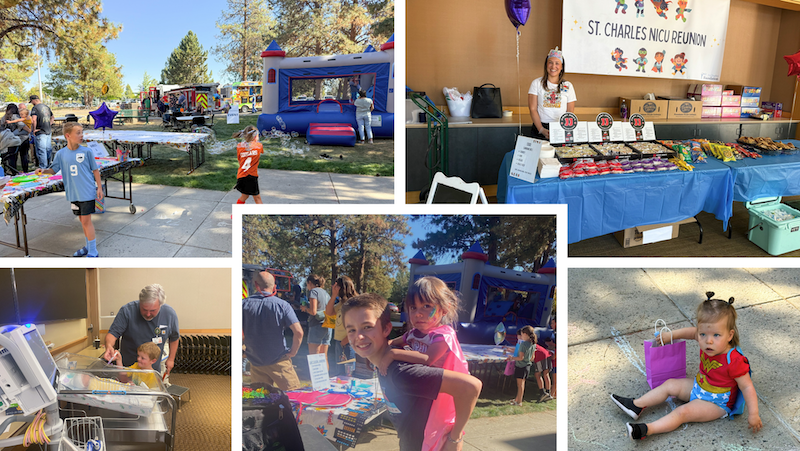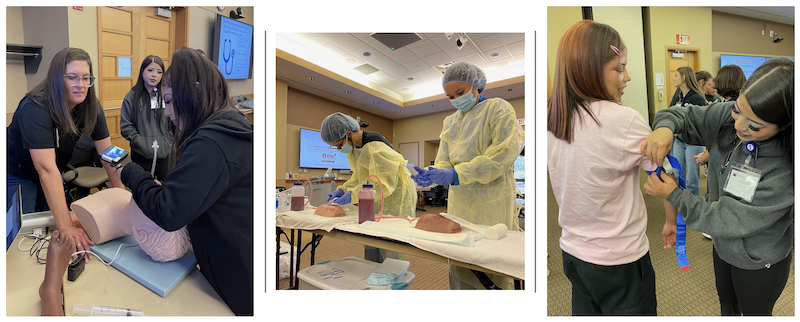There’s a new robot living inside St. Charles’ Prineville hospital, and it’s racking up win after win after win for patients, nurses, physicians, the health system and the Crook County community.
“I don’t know that it’s a robot because it doesn’t move around on its own,” said Dr. Bryan Harris, senior medical director of Acute Medicine Services for St. Charles. “To me, a robot is something that moves around independently and it’s got a computer screen on it.”
He’s being facetious, but the benefits of Prineville’s OK-maybe-it’s-not-a-robot are no joke. Since early January, St. Charles hospitalists based in Redmond have been admitting patients to the Prineville hospital using Teladoc, a telehealth platform used by thousands of providers across the United States.
The program started in response to growing gaps in nighttime coverage at the Prineville hospital, where Family Care physicians have historically taken overnight on-call shifts in addition to seeing clinic patients during the day.
“There aren’t many places around that still have that kind of call structure, where you basically have a full-time clinic plus 24-hour call,” said Prineville’s Chief Medical Officer, Dr. Maggie King. “So that was becoming very difficult for our providers, and it was becoming an obstacle to recruiting new docs to come here.”
There are companies that will contract with hospitals to provide third-party coverage — an option neither Harris nor King believe would be best for Prineville.
“I fear that an outside group would just say, ‘OK, transfer this one, transfer that one’ and not be engaged,” said Harris, who oversees the hospitalist group that covers the Bend and Redmond hospitals.
“My group is internal. We know the systems. We know the specialists. Some of us have worked in Prineville. We know what can stay there and what needs to go to Bend or Redmond,” he continued. “Some of the patients there, we’ve cared for in person. So yes, it’s way better for us to do it than an outside system.”
King concurred: “It really is the best of all worlds to have our own team — our fabulous Redmond team — providing that coverage for us.”
Harris asked a subset of his group — the physicians who provide nighttime coverage in Redmond — to do the same for Prineville using telehealth technology. Once they agreed, he spent months driving to Prineville and working with people across the health system to plan workflows, test equipment and generally make sure all involved were comfortable with the program.
“We may have had a few people who were reticent, but so far, it’s been very successful and everyone seems to feel like it’s going well,” he said.
Patients seem to have embraced the program; about 225 have been admitted to the hospital remotely this year, and only two have declined to be seen via Teladoc. Physicians use a two-step process when deciding how to handle a patient: First, they review their chart and speak to their Prineville-based caregiver. Then, they ask the patient if they are comfortable being evaluated by a physician through a computer screen.
“People might say, ‘Well, this is kind of weird.’ And we say, ‘Yeah, it’s weird for us, too. But after hearing about your situation, I think this is good enough, and tomorrow you’ll get a real person,’” he said. “People don’t want to be transferred to the Bend hospital. They want their care locally. People in Prineville want to be in the Prineville hospital.”
He continued: “There are limitations, of course, and I still prefer face-to face. But when that’s not possible, this has been a really effective substitute.”
The proof is in the numbers: In 2025, transfers from Prineville have dropped, from 1,085 in 2024 to 842 this year, while transfers due to capacity have dropped from 78 to 18. So not only are more Crook County patients getting the care they need closer to home, but by staying in Prineville, they are not adding to the census at the Bend hospital, where capacity is a regular concern.
They’re also reducing ambulance trips between Prineville, Bend and Redmond, and helping to keep Crook County Fire & Rescue crews in their home county, King said.
“Not transferring people is always preferable to transferring them,” she said. “It’s safer, it costs less money and it’s good for our EMS partners.”
There are other benefits, too. Prineville’s Family Care clinic can maintain access and provide more robust outpatient care with physicians who aren’t balancing daily patient visits with night call. And nurses at the hospital like Teladoc because it means when they must call a physician in the middle of the night, they’re calling someone who is awake and working rather than someone who is on call at home, often asleep after a long day in clinic, said Jennifer Pence, director of Patient Care Services in Prineville.
“There was some learning curve, of course, but overall, I think the nurses feel really well-supported because they know they can call someone who is awake, logged into a computer and already in a working frame of mind,” Pence said. “It’s been really great.”
Both Harris and King said they foresee a future where Teladoc plays a role in the care St. Charles provides at other outlying hospitals. For now, though, they are enjoying the fruits of the months of work that went into planning and operationalizing the remote admissions system.
“I think it has turned out exactly like we were hoping,” Harris said. “There have been a few bumps along the way, but otherwise this has been a win all the way around.”




